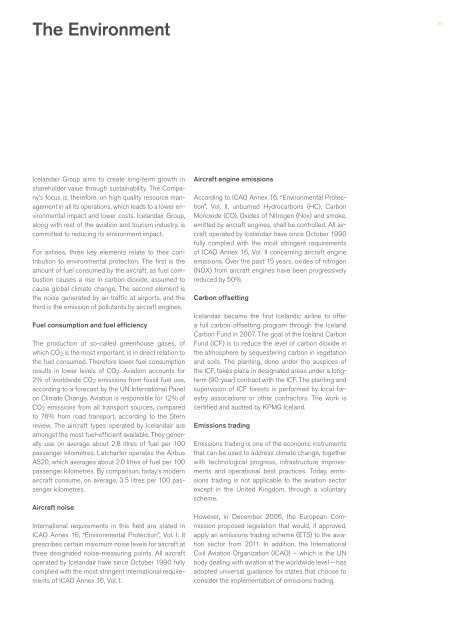Icelandair Group Annual Report 2007
Icelandair Group Annual Report 2007
Icelandair Group Annual Report 2007
You also want an ePaper? Increase the reach of your titles
YUMPU automatically turns print PDFs into web optimized ePapers that Google loves.
The Environment<br />
37<br />
<strong>Icelandair</strong> <strong>Group</strong> aims to create long-term growth in<br />
shareholder value through sustainability. The Company’s<br />
focus is, therefore, on high quality resource management<br />
in all its operations, which leads to a lower environmental<br />
impact and lower costs. <strong>Icelandair</strong> <strong>Group</strong>,<br />
along with rest of the aviation and tourism industry, is<br />
committed to reducing its environment impact.<br />
For airlines, three key elements relate to their contribution<br />
to environmental protection. The first is the<br />
amount of fuel consumed by the aircraft, as fuel combustion<br />
causes a rise in carbon dioxide, assumed to<br />
cause global climate change. The second element is<br />
the noise generated by air traffic at airports, and the<br />
third is the emission of pollutants by aircraft engines.<br />
Fuel consumption and fuel efficiency<br />
The production of so-called greenhouse gases, of<br />
which CO 2 is the most important, is in direct relation to<br />
the fuel consumed. Therefore lower fuel consumption<br />
results in lower levels of CO 2 . Aviation accounts for<br />
2% of worldwide CO 2 emissions from fossil fuel use,<br />
according to a forecast by the UN International Panel<br />
on Climate Change. Aviation is responsible for 12% of<br />
CO 2 emissions from all transport sources, compared<br />
to 76% from road transport, according to the Stern<br />
review. The aircraft types operated by <strong>Icelandair</strong> are<br />
amongst the most fuel-efficient available. They generally<br />
use on average about 2.8 litres of fuel per 100<br />
passenger kilometres. Latcharter operates the Airbus<br />
A320, which averages about 2.0 litres of fuel per 100<br />
passenger kilometres. By comparison, today‘s modern<br />
aircraft consume, on average, 3.5 litres per 100 passenger<br />
kilometres.<br />
Aircraft noise<br />
International requirements in this field are stated in<br />
ICAO Annex 16, “Environmental Protection”, Vol. I. It<br />
prescribes certain maximum noise levels for aircraft at<br />
three designated noise-measuring points. All aircraft<br />
operated by <strong>Icelandair</strong> have since October 1990 fully<br />
complied with the most stringent international requirements<br />
of ICAO Annex 16, Vol. I.<br />
Aircraft engine emissions<br />
According to ICAO Annex 16, “Environmental Protection”,<br />
Vol. II, unburned Hydrocarbons (HC), Carbon<br />
Monoxide (CO), Oxides of Nitrogen (Nox) and smoke,<br />
emitted by aircraft engines, shall be controlled. All aircraft<br />
operated by <strong>Icelandair</strong> have since October 1990<br />
fully complied with the most stringent requirements<br />
of ICAO Annex 16, Vol. II concerning aircraft engine<br />
emissions. Over the past 15 years, oxides of nitrogen<br />
(NOX) from aircraft engines have been progressively<br />
reduced by 50%.<br />
Carbon offsetting<br />
<strong>Icelandair</strong> became the first Icelandic airline to offer<br />
a full carbon offsetting program through the Iceland<br />
Carbon Fund in <strong>2007</strong>. The goal of the Iceland Carbon<br />
Fund (ICF) is to reduce the level of carbon dioxide in<br />
the atmosphere by sequestering carbon in vegetation<br />
and soils. The planting, done under the auspices of<br />
the ICF, takes place in designated areas under a longterm<br />
(90-year) contract with the ICF. The planting and<br />
supervision of ICF forests is performed by local forestry<br />
associations or other contractors. The work is<br />
certified and audited by KPMG Iceland.<br />
Emissions trading<br />
Emissions trading is one of the economic instruments<br />
that can be used to address climate change, together<br />
with technological progress, infrastructure improvements<br />
and operational best practices. Today, emissions<br />
trading is not applicable to the aviation sector<br />
except in the United Kingdom, through a voluntary<br />
scheme.<br />
However, in December 2006, the European Commission<br />
proposed legislation that would, if approved,<br />
apply an emissions trading scheme (ETS) to the aviation<br />
sector from 2011. In addition, the International<br />
Civil Aviation Organization (ICAO) – which is the UN<br />
body dealing with aviation at the worldwide level – has<br />
adopted universal guidance for states that choose to<br />
consider the implementation of emissions trading.

















